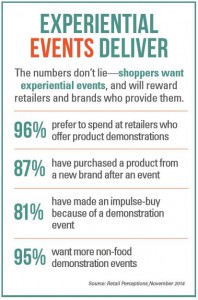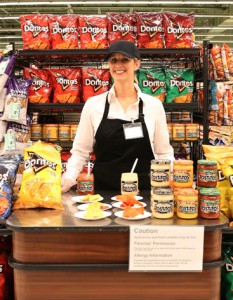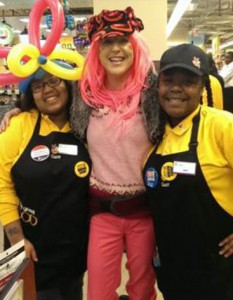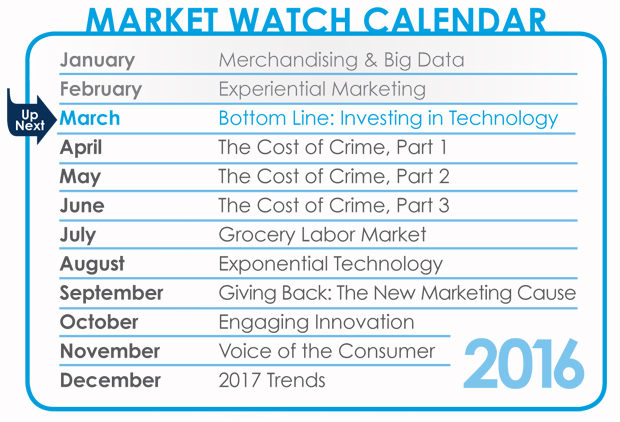
Eighty-seven percent of consumers say live events are more effective than TV commercials. –Event Marketing Institute, EventTrack 2015
—–
By Retail News Insider
Well-executed experiential events evoke emotions, stimulate the senses and help build the relationship between the retailer and the consumer.
Events like chef demonstrations, outdoor grilling events and grand openings featuring face painters, musicians and balloon artists can drive sales, increase loyalty and prompt word-of-mouth referrals. In essence, they create a shopping experience that online retailers simply can’t match.
As the demand for personalized connections grows among consumers, so does the need for retailers and brands to building experiential marketing programs to engage with their audience. The problem for many retailers and brands is knowing where to start. Some hesitate to create a program because they think it’s too expensive, or time or labor intensive. Yet with over 70 percent of purchasing decisions being made in the store (according to trade group Point of Purchase Advertising International )—and 98 percent of consumers saying they’re more likely to purchase a product after experiencing it at a live event (according to market research firm Event Marketing Institute)—experiential marketing programs have simply become too valuable to ignore.
Fortunately, it is possible to build and execute a program that benefits any retailer, no matter their size, budget or prior experience. Here’s a look at several of the key best practices for building an experiential marketing program that sets your store apart.
First Things First 
Experts stress that one of the most important things to keep in mind for retailers who are just starting out with experiential marketing is to start small. “Don’t think you need to blow out the budget,” says Ryan Dee, Senior Account Executive for Interactions. “It’s best to start smaller and see what will work for you and your customers first.”
A global leader in experiential marketing events, Interactions often relies on pilot programs to get its retailer partners started with an experiential marketing campaign. “We might do 10 or 12 events in a few stores to show the retailer how the program will work. This way the retailer doesn’t have to make a large commitment right off the bat. We can test different ideas and see what resonates best with shoppers,” explains Dee.
As an example of how a small pilot program can work, Lauren Smith, Account Executive for Interactions, describes a recent pilot executed for a supermarket chain in the Northeast. “The retailer wanted to increase awareness and sales in its beauty care category. We helped develop a pilot program of in-store beauty events, which involved monthly in-store ‘makeover’ events in 10 stores over a 6-month period. That showed the retailer how the program would work if rolled out to all of its 85 stores, and also proved that the events would generate sustained sales lift.”
Single events, as opposed to ongoing programs, are also an option. Retailers can start their experiential marketing campaigns with grand opening or reopening events. “A grand opening can help a retailer deliver the best first impression—using trained, experienced Brand Ambassadors to build a relationship with the customer right from the start,” says Smith. “There’s no commitment for the retailer beyond that single event, though many clients choose to do additional because of the sustained excitement they generate.”
Creating a Concept
Once a retailer chooses to start a program, the next step is to decide on a theme or concept. Retailers should begin by knowing their customers and having an idea of what they want their experiential marketing program to achieve. These two areas will help build a program that will resonate with their core audience.
Having a clear vision for the outcome is critical for operational success, says Micah Wightman, Director of Operations for Interactions. “There aren’t too many things we can’t do when retailers are clear on what they want,” he explains. “But if they aren’t, it presents extra challenges.”
To identify concepts and build themes, Interactions relies on in-depth shopper and community research to create concepts that are unique to each program. Brand Ambassadors can also provide critical direction as they can determine what will resonate with consumers who live in the local community where a retailer or brand wants to host an event.
By researching and aligning with the core customer, retailers have a better chance of ensuring the success of any event marketing program.
Finally, by identifying the goals for the program, retailers can measure success in terms of attendance, social media mentions, leads or post-event sales. These metrics will guide the development of the program.
Building a Staff that Embodies Your Brand
After choosing a concept, the next step is to create a clear plan for execution. “Front-line staffing is a critical aspect of executing a successful experiential marketing campaign—and often the one that needs the most support,” says Tracy Johnson, Senior Account Executive for Interactions. “It’s the first thing we work on from an operational perspective. It takes time to source and develop adequate levels of staffing and to ensure event staff are qualified and trained to represent a retailer or brand.”
While retailers developing their own programs might at first consider staffing events with existing associates, Wightman warns that comes with disadvantages. “When retailers have their own employees try to do an event, they’ll frequently be pulled off to do their regular job,” he says. “That makes it hard to consistently execute and measure the outcome of an event. The retailer may have planned a 6-hour event, but their employee was only able to devote 4 hours to it. In that case, the true potential of the event won’t be reflected in the sales.”
Wightman also cautions against trying to save on budget by hiring staff at lower wages. “When you pay a higher hourly rate, you tend to get a higher-quality Brand Ambassador,” he says. “Time and time again we’ve seen that spending a little more up front on staffing pays off with much higher returns-on-investment (ROIs).”
“There’s a big difference between someone who is just handing out samples and someone who is excited to share the product with consumers and really knows and embodies the brand,” adds Johnson.
The Finer Details
When it comes to planning, execution or any other aspect of ensuring a successful program, experts stress the importance of looking not just at the big picture, but also the finer details. Depending on the program, this may include everything from supply logistics, to ensuring all staff that handles food is food-safety certified, to tracking and analyzing measures of a programs outcome, such as sales lift, loyalty sign-ups or consumer impressions, in order to calculate ROI.
“There’s a lot of due diligence that has to happen,” says Dee. “The benefit of working with an experience company like Interactions is that we take care of ensuring that all details are attended to.”
Communicating all of these relevant details to and ensuring an ongoing dialog between the different parties involved in each aspect is another key to executing a successful experiential program. From the Brand Ambassador executing the event, to the store manager hosting it, to the category manager whose product is featured—everyone needs to be informed and involved in order to build consistency and continuity.
As Interactions’ experts point out, program consistency and continuity are critical to producing successful events that reinforce the brand experience and provide the ultimate payoff for retailers. “The most successful experiential marketing programs are those that give shoppers the same experience no matter what store they go into. That cements the retailer’s cultural and brand identity for shoppers,” concludes Dee.


